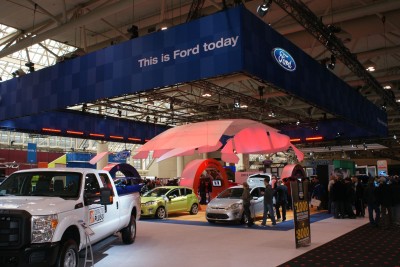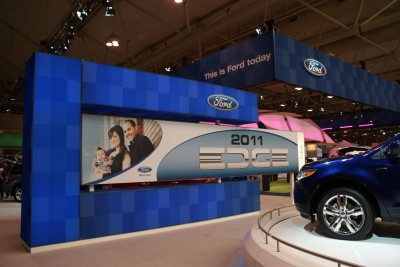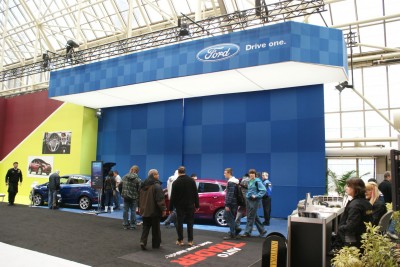Sign Shop Profile: McRae Imaging
by Matthew | 18 February 2012 3:48 pm
 [1]By Peter Saunders
[1]By Peter Saunders
Since 1997, McRae Imaging in Mississauga, Ont., has gradually made a name for itself in the wide-format graphics industry both through good fortune and by focusing on niche applications. Rather than operate as a full-service print provider, it has specialized in dye sublimation for the trade, outputting graphics on textile substrates and integrating them into custom-fabricated structures, often for trade shows and other special events.
“Within the trade, people are very aware of us,” says Bob Murray, president, “but we should do more in terms of communications, as it’s been mostly word-of-mouth so far.”
Cutting their teeth
The company has its roots in McRae Custom Colour Labs, which provided photographic services on Stafford Street in downtown Toronto since the mid-1960s. Murray bought the company with business partner Richard Kisiel in 1997. They began to transition its operations to take advantage of newer graphic processes, including digital wide-format inkjet printing.
“The Custom Colour Labs business was almost dead when we bought it,” says Murray. “We saw the traditional photographic industry heading the way of the dodo.”
The next few years continued to see rapid technological change. In 1998, Murray investigated dye sublimation printing—which was then emerging in European markets—for the production of graphics on fabric substrates. He pitched the technology to Kisiel, then vice-president (VP) of production, who agreed to try it in-house.
 [2]“We had a pigment printer and could do heat transfers and run dye-sub inks through it,” says Murray, currently the company’s president. “We got the process going in 1999 and were able to cut our teeth on it while the technology was still in its early days.”
[2]“We had a pigment printer and could do heat transfers and run dye-sub inks through it,” says Murray, currently the company’s president. “We got the process going in 1999 and were able to cut our teeth on it while the technology was still in its early days.”
While the timing gave them a competitive advantage over other print shops, it also made for a steep learning curve, as there were few others’ examples to follow.
“It’s a combination of science and art and it’s difficult to get right,” says Murray. “In the early days, we developed all of our own colour profiles, spending months refining them. We were used to colour management in the photo industry, but as different fabrics absorb the ink, the colours do not look the same. I remember struggling just to get the three colours right on the Michelin Man! Just when you think you’ve overcome the difficulties, you run into another obstacle.”
The right place at the right time
McRae’s dye-sub output grew dramatically but steadily over the next few years, serving customers in the trade-show sector. The company bent aluminum extrusions into expo booth frames, then stretched the fabrics over them.
“We had already been mounting graphics to rigid polyvinyl chloride (PVC) boards for trade show displays, so it made sense to continue to move that way,” says Murray. “We became the printer of record for Expand International, a company in Sweden that had introduced fabric displays to the North American market. So, we were the first guys to get into this work here—and there was no problem with rebranding ourselves. It was a matter of being in the right place at the right time!”
Another key to McRae’s success, however, involved avoiding the common mistake of rushing too quickly into a new business model.
“An amount of caution is always needed,” says Murray. “When we started, we didn’t have much money or access to credit, but that may have been a good thing. While some companies were bankrupting themselves splurging on new technologies every few years, we started with one dye-sub machine and added more in such a way that everything was synchronized. We bought new equipment only as new jobs were coming in. The best advice is to take some easy steps, learn more, take time, become profitable and don’t kill yourself. An amount of caution is always needed.”
 [3]Drivers of growth
[3]Drivers of growth
Trade show exhibitors were keen on fabric-based soft signage for a variety of reasons. Initially, it helped their branded graphics stand out from the crowd. Another benefit, however, was the low weight of the material compared to rigid substrates.
“Reducing the weight of trade show display components is actually a big deal in terms of reducing the costs of transportation,” Murray says. “You can just roll up the graphics and go. That small, light, portable side of the business has seen exponential growth.”
The overall trade show business has seen a downward trend, however, with fewer big events in recent years. Among McRae’s customer base, this difference has been more pronounced in the U.S. than in Canada.
“The U.S. used to represent 30 to 40 per cent of our business, but now it’s closer to 25 per cent,” Murray says. “Some of the economic growth in Canada has made up for that. We’re also fortunate that we don’t specifically serve the event industry itself, but instead work with people who decide upon the graphic applications. So, we custom-integrate fabrics and aluminum structures into very big displays for annual meetings and other events that have taken budgets away from trade shows. We’ve created backdrops for baseball games, for example, and massive outdoor tents with dye-sublimated graphics. Our business is changing every day.”
McRae has also targeted point-of-purchase (POP) applications in retail stores, where there seems to be greater potential for growth.
“In the past two years, we’ve had some of our trade show projects transfer into retail projects,” he says. “We produced more than 600 fabric ‘halos’ for Circuit City, for example, to help identify the different product areas within a store; but we only got 100 or so installed before they went out of business! And there have been other, smaller opportunities.”
He also says pursuing this market will require a long-term view.
“Most POP graphics here in Canada are still PVC, which is cheaper,” says Murray, “whereas in certain markets in Europe, they’re way ahead in using fabrics instead.”
 [4]Further integration
[4]Further integration
McRae now comprises a staff of 40 in a 2,323-m2 (25,000-sf) facility. In addition to dye-sub printing on 13 presses, in-house capabilities include design services, structural fabrication, finishing and system integration.
“We haven’t grown every single year,” says Murray, “but this past year we have seen an increase of almost 50 per cent. The pattern depends partly on the market and partly on our changing capabilities. We manage cost containment well, we maintain our operations efficiently and our selling prices have always gone down so far.”
Having successfully established itself in a narrow field, the company recently joined the Specialty Graphic Imaging Association (SGIA) and acquired new systems to better integrate itself into the broader printing industry.
“There are still lots of issues specific to our work, but the machines are getting faster, achieving better quality and supporting greater substrate widths,” Murray says. “We’re constantly watching progress in research and development (R&D), including not only new printers, but also printhead technology, inks, fabrics and transfer papers.”
For more information, visit www.mcrae-imaging.com[5].
- [Image]: http://www.signmedia.ca/wp-content/uploads/2014/02/DSC01319.jpg
- [Image]: http://www.signmedia.ca/wp-content/uploads/2014/02/DSC01343.jpg
- [Image]: http://www.signmedia.ca/wp-content/uploads/2014/02/DSC01306.jpg
- [Image]: http://www.signmedia.ca/wp-content/uploads/2014/02/DSC01330.jpg
- www.mcrae-imaging.com: http://www.mcrae-imaging.com
Source URL: https://www.signmedia.ca/profile-mcrae-imaging/